Jiacheng Deng
Bridge 2D-3D: Uncertainty-aware Hierarchical Registration Network with Domain Alignment
Apr 02, 2025Abstract:The method for image-to-point cloud registration typically determines the rigid transformation using a coarse-to-fine pipeline. However, directly and uniformly matching image patches with point cloud patches may lead to focusing on incorrect noise patches during matching while ignoring key ones. Moreover, due to the significant differences between image and point cloud modalities, it may be challenging to bridge the domain gap without specific improvements in design. To address the above issues, we innovatively propose the Uncertainty-aware Hierarchical Matching Module (UHMM) and the Adversarial Modal Alignment Module (AMAM). Within the UHMM, we model the uncertainty of critical information in image patches and facilitate multi-level fusion interactions between image and point cloud features. In the AMAM, we design an adversarial approach to reduce the domain gap between image and point cloud. Extensive experiments and ablation studies on RGB-D Scene V2 and 7-Scenes benchmarks demonstrate the superiority of our method, making it a state-of-the-art approach for image-to-point cloud registration tasks.
SAS: Segment Any 3D Scene with Integrated 2D Priors
Mar 11, 2025Abstract:The open vocabulary capability of 3D models is increasingly valued, as traditional methods with models trained with fixed categories fail to recognize unseen objects in complex dynamic 3D scenes. In this paper, we propose a simple yet effective approach, SAS, to integrate the open vocabulary capability of multiple 2D models and migrate it to 3D domain. Specifically, we first propose Model Alignment via Text to map different 2D models into the same embedding space using text as a bridge. Then, we propose Annotation-Free Model Capability Construction to explicitly quantify the 2D model's capability of recognizing different categories using diffusion models. Following this, point cloud features from different 2D models are fused with the guide of constructed model capabilities. Finally, the integrated 2D open vocabulary capability is transferred to 3D domain through feature distillation. SAS outperforms previous methods by a large margin across multiple datasets, including ScanNet v2, Matterport3D, and nuScenes, while its generalizability is further validated on downstream tasks, e.g., gaussian segmentation and instance segmentation.
Beyond the Final Layer: Hierarchical Query Fusion Transformer with Agent-Interpolation Initialization for 3D Instance Segmentation
Feb 06, 2025Abstract:3D instance segmentation aims to predict a set of object instances in a scene and represent them as binary foreground masks with corresponding semantic labels. Currently, transformer-based methods are gaining increasing attention due to their elegant pipelines, reduced manual selection of geometric properties, and superior performance. However, transformer-based methods fail to simultaneously maintain strong position and content information during query initialization. Additionally, due to supervision at each decoder layer, there exists a phenomenon of object disappearance with the deepening of layers. To overcome these hurdles, we introduce Beyond the Final Layer: Hierarchical Query Fusion Transformer with Agent-Interpolation Initialization for 3D Instance Segmentation (BFL). Specifically, an Agent-Interpolation Initialization Module is designed to generate resilient queries capable of achieving a balance between foreground coverage and content learning. Additionally, a Hierarchical Query Fusion Decoder is designed to retain low overlap queries, mitigating the decrease in recall with the deepening of layers. Extensive experiments on ScanNetV2, ScanNet200, ScanNet++ and S3DIS datasets demonstrate the superior performance of BFL.
ErasableMask: A Robust and Erasable Privacy Protection Scheme against Black-box Face Recognition Models
Dec 24, 2024



Abstract:While face recognition (FR) models have brought remarkable convenience in face verification and identification, they also pose substantial privacy risks to the public. Existing facial privacy protection schemes usually adopt adversarial examples to disrupt face verification of FR models. However, these schemes often suffer from weak transferability against black-box FR models and permanently damage the identifiable information that cannot fulfill the requirements of authorized operations such as forensics and authentication. To address these limitations, we propose ErasableMask, a robust and erasable privacy protection scheme against black-box FR models. Specifically, via rethinking the inherent relationship between surrogate FR models, ErasableMask introduces a novel meta-auxiliary attack, which boosts black-box transferability by learning more general features in a stable and balancing optimization strategy. It also offers a perturbation erasion mechanism that supports the erasion of semantic perturbations in protected face without degrading image quality. To further improve performance, ErasableMask employs a curriculum learning strategy to mitigate optimization conflicts between adversarial attack and perturbation erasion. Extensive experiments on the CelebA-HQ and FFHQ datasets demonstrate that ErasableMask achieves the state-of-the-art performance in transferability, achieving over 72% confidence on average in commercial FR systems. Moreover, ErasableMask also exhibits outstanding perturbation erasion performance, achieving over 90% erasion success rate.
Three-in-One: Robust Enhanced Universal Transferable Anti-Facial Retrieval in Online Social Networks
Dec 23, 2024



Abstract:Deep hash-based retrieval techniques are widely used in facial retrieval systems to improve the efficiency of facial matching. However, it also carries the danger of exposing private information. Deep hash models are easily influenced by adversarial examples, which can be leveraged to protect private images from malicious retrieval. The existing adversarial example methods against deep hash models focus on universality and transferability, lacking the research on its robustness in online social networks (OSNs), which leads to their failure in anti-retrieval after post-processing. Therefore, we provide the first in-depth discussion on robustness adversarial perturbation in universal transferable anti-facial retrieval and propose Three-in-One Adversarial Perturbation (TOAP). Specifically, we construct a local and global Compression Generator (CG) to simulate complex post-processing scenarios, which can be used to mitigate perturbation. Then, we propose robust optimization objectives based on the discovery of the variation patterns of model's distribution after post-processing, and generate adversarial examples using these objectives and meta-learning. Finally, we iteratively optimize perturbation by alternately generating adversarial examples and fine-tuning the CG, balancing the performance of perturbation while enhancing CG's ability to mitigate them. Numerous experiments demonstrate that, in addition to its advantages in universality and transferability, TOAP significantly outperforms current state-of-the-art methods in multiple robustness metrics. It further improves universality and transferability by 5% to 28%, and achieves up to about 33% significant improvement in several simulated post-processing scenarios as well as mainstream OSNs, demonstrating that TOAP can effectively protect private images from malicious retrieval in real-world scenarios.
TOAP: Towards Better Robustness in Universal Transferable Anti-Facial Retrieval
Dec 12, 2024



Abstract:Deep hash-based retrieval techniques are widely used in facial retrieval systems to improve the efficiency of facial matching. However, it also brings the risk of privacy leakage. Deep hash models are easily influenced by adversarial examples, which can be leveraged to prevent the malicious retrieval of private images. The existing adversarial example methods against deep hash models focus on universality and transferability, lacking the research on its robustness in online social networks (OSNs), which leads to their failure in anti-retrieval after post-processing. Therefore, we provide the first in-depth discussion on robustness adversarial perturbation in universal transferable anti-facial retrieval and propose Three-in-One Adversarial Perturbation (TOAP). Specifically, we firstly analyze the performance of deep hash models after post-processing and construct a local and global Compression Generator (CG) to simulate complex post-processing scenarios. Then, we explore the variation patterns of the model's objective under image post-processing and propose robust optimization objectives, cluster centers and data space centers, optimizing them using meta-learning. Finally, we iteratively optimize perturbation by alternately generating adversarial examples and fine-tuning the CG, balancing the performance of perturbation while enhancing CG's ability to mitigate them. Numerous experiments demonstrate that, in addition to its advantages in universality and transferability, TOAP significantly outperforms current state-of-the-art methods in multiple robustness metrics. It further improves universality and transferability by 5% to 28%, and achieves up to about 33% significant improvement in several simulated post-processing scenarios as well as mainstream OSNs, demonstrating that TOAP can effectively protect private images from malicious retrieval in real-world scenarios.
Take Fake as Real: Realistic-like Robust Black-box Adversarial Attack to Evade AIGC Detection
Dec 09, 2024Abstract:The security of AI-generated content (AIGC) detection based on GANs and diffusion models is closely related to the credibility of multimedia content. Malicious adversarial attacks can evade these developing AIGC detection. However, most existing adversarial attacks focus only on GAN-generated facial images detection, struggle to be effective on multi-class natural images and diffusion-based detectors, and exhibit poor invisibility. To fill this gap, we first conduct an in-depth analysis of the vulnerability of AIGC detectors and discover the feature that detectors vary in vulnerability to different post-processing. Then, considering the uncertainty of detectors in real-world scenarios, and based on the discovery, we propose a Realistic-like Robust Black-box Adversarial attack (R$^2$BA) with post-processing fusion optimization. Unlike typical perturbations, R$^2$BA uses real-world post-processing, i.e., Gaussian blur, JPEG compression, Gaussian noise and light spot to generate adversarial examples. Specifically, we use a stochastic particle swarm algorithm with inertia decay to optimize post-processing fusion intensity and explore the detector's decision boundary. Guided by the detector's fake probability, R$^2$BA enhances/weakens the detector-vulnerable/detector-robust post-processing intensity to strike a balance between adversariality and invisibility. Extensive experiments on popular/commercial AIGC detectors and datasets demonstrate that R$^2$BA exhibits impressive anti-detection performance, excellent invisibility, and strong robustness in GAN-based and diffusion-based cases. Compared to state-of-the-art white-box and black-box attacks, R$^2$BA shows significant improvements of 15% and 21% in anti-detection performance under the original and robust scenario respectively, offering valuable insights for the security of AIGC detection in real-world applications.
DN-4DGS: Denoised Deformable Network with Temporal-Spatial Aggregation for Dynamic Scene Rendering
Oct 17, 2024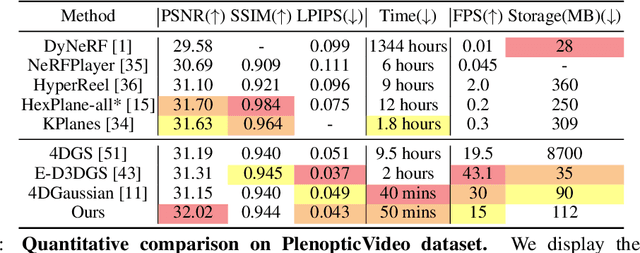
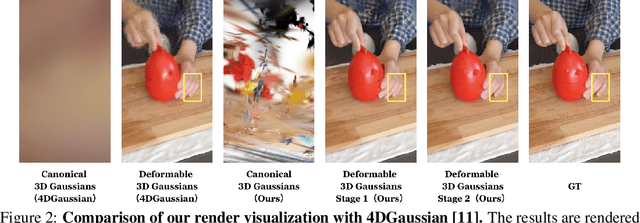
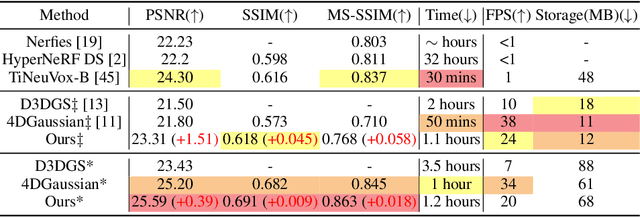

Abstract:Dynamic scenes rendering is an intriguing yet challenging problem. Although current methods based on NeRF have achieved satisfactory performance, they still can not reach real-time levels. Recently, 3D Gaussian Splatting (3DGS) has gar?nered researchers attention due to their outstanding rendering quality and real?time speed. Therefore, a new paradigm has been proposed: defining a canonical 3D gaussians and deforming it to individual frames in deformable fields. How?ever, since the coordinates of canonical 3D gaussians are filled with noise, which can transfer noise into the deformable fields, and there is currently no method that adequately considers the aggregation of 4D information. Therefore, we pro?pose Denoised Deformable Network with Temporal-Spatial Aggregation for Dy?namic Scene Rendering (DN-4DGS). Specifically, a Noise Suppression Strategy is introduced to change the distribution of the coordinates of the canonical 3D gaussians and suppress noise. Additionally, a Decoupled Temporal-Spatial Ag?gregation Module is designed to aggregate information from adjacent points and frames. Extensive experiments on various real-world datasets demonstrate that our method achieves state-of-the-art rendering quality under a real-time level.
MotionGS: Exploring Explicit Motion Guidance for Deformable 3D Gaussian Splatting
Oct 10, 2024



Abstract:Dynamic scene reconstruction is a long-term challenge in the field of 3D vision. Recently, the emergence of 3D Gaussian Splatting has provided new insights into this problem. Although subsequent efforts rapidly extend static 3D Gaussian to dynamic scenes, they often lack explicit constraints on object motion, leading to optimization difficulties and performance degradation. To address the above issues, we propose a novel deformable 3D Gaussian splatting framework called MotionGS, which explores explicit motion priors to guide the deformation of 3D Gaussians. Specifically, we first introduce an optical flow decoupling module that decouples optical flow into camera flow and motion flow, corresponding to camera movement and object motion respectively. Then the motion flow can effectively constrain the deformation of 3D Gaussians, thus simulating the motion of dynamic objects. Additionally, a camera pose refinement module is proposed to alternately optimize 3D Gaussians and camera poses, mitigating the impact of inaccurate camera poses. Extensive experiments in the monocular dynamic scenes validate that MotionGS surpasses state-of-the-art methods and exhibits significant superiority in both qualitative and quantitative results. Project page: https://ruijiezhu94.github.io/MotionGS_page
Plane2Depth: Hierarchical Adaptive Plane Guidance for Monocular Depth Estimation
Sep 04, 2024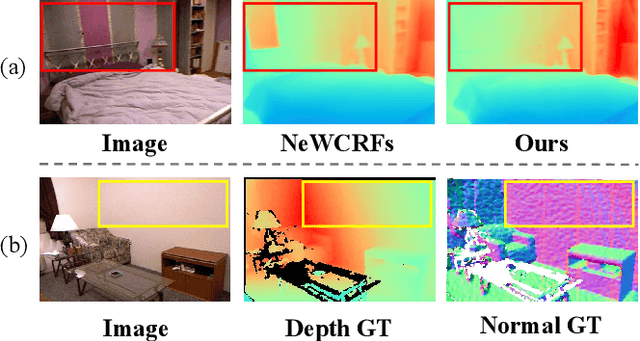
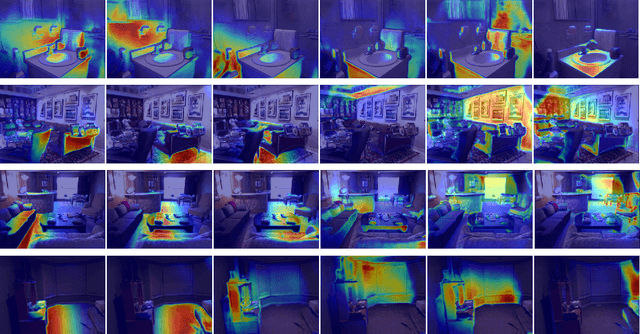
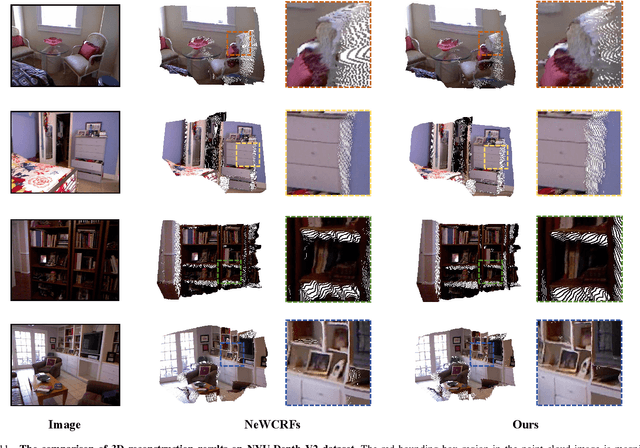
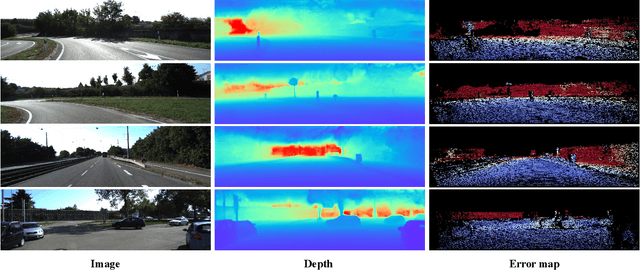
Abstract:Monocular depth estimation aims to infer a dense depth map from a single image, which is a fundamental and prevalent task in computer vision. Many previous works have shown impressive depth estimation results through carefully designed network structures, but they usually ignore the planar information and therefore perform poorly in low-texture areas of indoor scenes. In this paper, we propose Plane2Depth, which adaptively utilizes plane information to improve depth prediction within a hierarchical framework. Specifically, in the proposed plane guided depth generator (PGDG), we design a set of plane queries as prototypes to softly model planes in the scene and predict per-pixel plane coefficients. Then the predicted plane coefficients can be converted into metric depth values with the pinhole camera model. In the proposed adaptive plane query aggregation (APGA) module, we introduce a novel feature interaction approach to improve the aggregation of multi-scale plane features in a top-down manner. Extensive experiments show that our method can achieve outstanding performance, especially in low-texture or repetitive areas. Furthermore, under the same backbone network, our method outperforms the state-of-the-art methods on the NYU-Depth-v2 dataset, achieves competitive results with state-of-the-art methods KITTI dataset and can be generalized to unseen scenes effectively.
 Add to Chrome
Add to Chrome Add to Firefox
Add to Firefox Add to Edge
Add to Edge